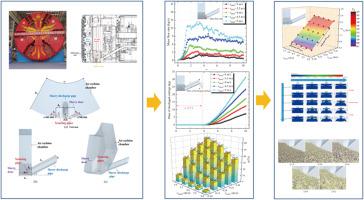当前位置:
X-MOL 学术
›
Particuology
›
论文详情
Our official English website, www.x-mol.net, welcomes your feedback! (Note: you will need to create a separate account there.)
Research on the cuttings discharge in air cushion chamber of slurry shield based on CFD-DEM coupling method
Particuology ( IF 3.5 ) Pub Date : 2024-03-15 , DOI: 10.1016/j.partic.2024.02.008 Han Wang , Wantao Ding , Weimin Yang , Chengzhen Wang , Wenduan Yu , Zhicheng Wang
Particuology ( IF 3.5 ) Pub Date : 2024-03-15 , DOI: 10.1016/j.partic.2024.02.008 Han Wang , Wantao Ding , Weimin Yang , Chengzhen Wang , Wenduan Yu , Zhicheng Wang

|
The rapid discharge of cuttings from the air cushion chamber is crucial for the construction safety and excavation efficiency of the slurry shield. Previous studies have mainly focused on the transport characteristics of cuttings in the slurry discharge pipe, while the complete process of cuttings entering the slurry discharge pipe from the air cushion chamber until they are discharged was often overlooked. Based on the CFD-DEM coupling method and combined with actual engineering, this paper established a numerical model that can more completely reflect the cuttings discharge process during slurry shield tunneling, and the effects of the slurry velocity at slurry gate and scouring pipes, inclination angle of slurry discharge pipe, cuttings diameter and shape coefficient were investigated by analyzing the variation in the mass flow rate, mass of discharged cuttings, and discharged ratio. The results revealed that increasing the slurry velocity can promote the discharge of cuttings. To keep the discharged rate at a high level, it is recommended that the slurry velocity at the slurry gate should be greater than 0.15 m/s. Reducing the inclination angle of the discharge pipe is conducive to the rapid discharge of cuttings. Cuttings with large diameter or small shape coefficient are more prone to accumulate in the air cushion chamber and cause clogging risk. The research results not only help to improve engineers' understanding of cuttings discharge in slurry shield, but also provide practical guidance for formulating relevant construction measures.
中文翻译:

基于CFD-DEM耦合方法的泥水盾构气垫室岩屑排出研究
气垫室岩屑的快速排出对于泥水盾构的施工安全和挖掘效率至关重要。以往的研究主要集中于岩屑在排浆管中的输送特性,而往往忽视了岩屑从气垫室进入排浆管直至排出的完整过程。基于CFD-DEM耦合方法,结合工程实际,建立了能够较为完整地反映泥水盾构掘进过程中岩屑排出过程的数值模型,以及泥浆闸门和冲刷管处泥浆速度、倾角的影响。通过分析泥浆排出管的质量流量、排出岩屑质量和排出比例的变化,研究岩屑直径和形状系数。结果表明,提高泥浆流速可以促进岩屑的排出。为保持较高的排出量,建议料浆口处的料浆速度应大于0.15 m/s。减小排出管的倾斜角度,有利于岩屑的快速排出。大直径或小形状系数的切屑更容易堆积在气垫室中并造成堵塞风险。研究成果不仅有助于提高工程师对泥水盾构岩屑排放的认识,也为制定相关施工措施提供实践指导。
更新日期:2024-03-15
中文翻译:

基于CFD-DEM耦合方法的泥水盾构气垫室岩屑排出研究
气垫室岩屑的快速排出对于泥水盾构的施工安全和挖掘效率至关重要。以往的研究主要集中于岩屑在排浆管中的输送特性,而往往忽视了岩屑从气垫室进入排浆管直至排出的完整过程。基于CFD-DEM耦合方法,结合工程实际,建立了能够较为完整地反映泥水盾构掘进过程中岩屑排出过程的数值模型,以及泥浆闸门和冲刷管处泥浆速度、倾角的影响。通过分析泥浆排出管的质量流量、排出岩屑质量和排出比例的变化,研究岩屑直径和形状系数。结果表明,提高泥浆流速可以促进岩屑的排出。为保持较高的排出量,建议料浆口处的料浆速度应大于0.15 m/s。减小排出管的倾斜角度,有利于岩屑的快速排出。大直径或小形状系数的切屑更容易堆积在气垫室中并造成堵塞风险。研究成果不仅有助于提高工程师对泥水盾构岩屑排放的认识,也为制定相关施工措施提供实践指导。



























 京公网安备 11010802027423号
京公网安备 11010802027423号